How to Grow & Care for Gaura Plant (Wandflower)
Written by Iris
Nov 03 2021
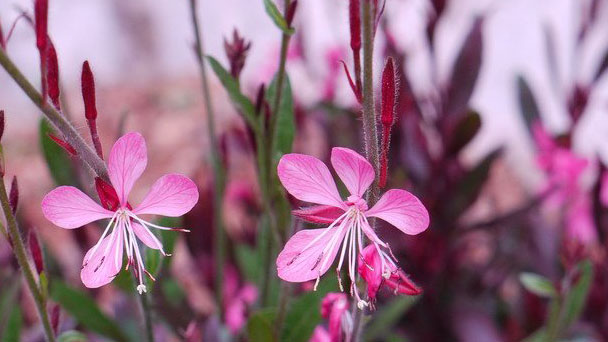
Gaura plants (Wandflower) are found in entire gardens in the Southwestern United States, both wild and native. Gaura plant appear on their own in late spring and bloom as temperatures rise. Gaura plants are a bit like weeds, partly because they tend to appear where they are, and partly because Gaura has a higher leaf-flower ratio.
Take care to choose your planting site well. Because these plants have deep taproots, they do not like to be moved once established. So, propagation by division is a less successful method.
Be sure to give your plants and bushes enough room to grow successfully. Give the smaller varieties about a foot of space all around. Larger shrubs should have at least 15″ inches between bushes at the time of planting.
Avoid moving a stationary Gaura plant from one location in your yard or garden to another. The mature plants do not do well when they are dug up and moved. It's better to begin anew with a different plant than to try to move an existing one.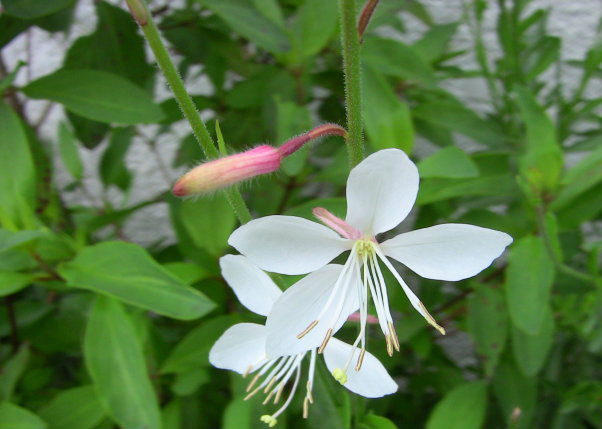
You can plant your potted Gaura seed in a well-prepared bed, or plant them as individual bushes and shrubs. To do this, you must dig a large hole that allows ample room for root growth. It should be the same depth as the pot your plant is in. But, it should be twice as wide.
Gently remove the plant from its pot and place it in the hole. Add or remove soil so that the top of the root ball is even with the top of the hole. Cover the roots in the ground as they were in the pot.
Once you have positioned the plant, fill in the hole with soil that will provide good drainage and root aeration. Improve heavy or high clay soil by adding coarse sand and well-rotted manure.
It's best to plant potted Gaura later in the growing season. Let your spring flowers have their day. As they are fading back, introduce gaura plant to add a splash of color and life to your declining garden.
In fact, this plant comes in very handy as a filler. When other plants start to wilt, cut them back and replace them with this pretty, rugged plant. These carefree plants fill empty spaces with billows of blossoms.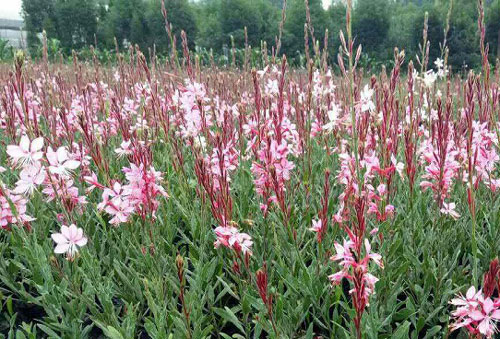
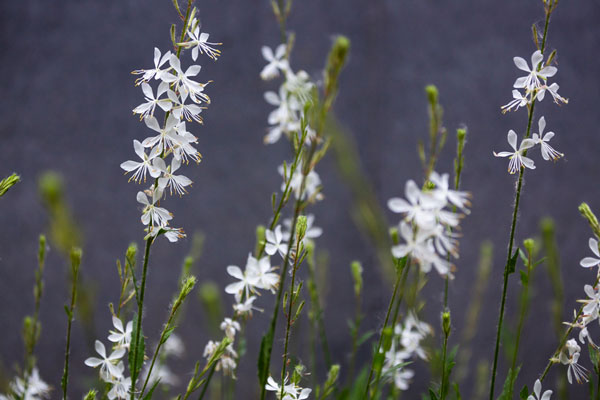
Corrie's Gold: The gold in this plant refers not to the flowers, but to the marvelous variegated foliage. Flowers are white tinged with pink.
Crimson Butterflies: Bright pink flowers on red stems hover above burgundy foliage. Partner them with blue or green-flowering plants for a head-turning combination.
Passionate Rainbow: As if the pink flower wands weren’t enough, the foliage is also edged in pink.
Siskiyou Pink: These showy rose-pink flowers are the most common variety in the trade.
Sparkle White: Dainty white flowers are tinged with pink in this elegant gaura variety. It received the Fleuroselect Gold Medal in 2014 for its beauty and garden performance.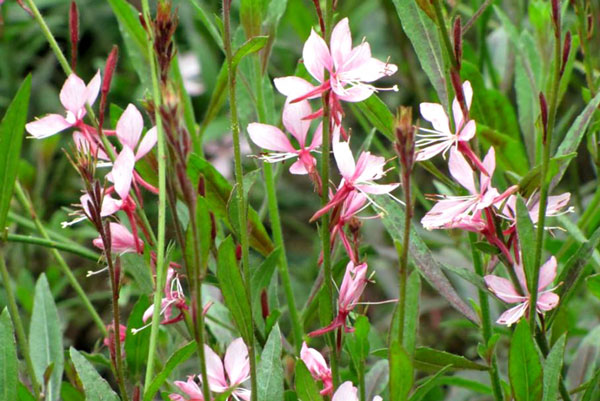
Where to Grow Gauras PlantHow to Grow Gaura Plant (Wandflower)Gaura Plant Propagation with SeedsGaura Plant Propagation with DivisionHow to Care for Gaura Plant (Wandflower)Gaura Plant Lighting RequirementsGaura Plant Soil CareGaura Plant WateringGaura Plant Fertilizer CarePruning Gaura PlantGaura Plant Pests & Diseases CareVarieties of Gaura Plant (Wandflower)Gaura Plant Care FAQShould I deadhead Gaura Plant?How do you take care of gaura plant in the winter?Is Gaura plant winter hardy?
Where to Grow Gauras Plant
Gauras are prarie plants native to the southern states of the USA and Mexico and need a warm sunny position. They tolerate partial shade and need moist but well drained soil.Take care to choose your planting site well. Because these plants have deep taproots, they do not like to be moved once established. So, propagation by division is a less successful method.
Be sure to give your plants and bushes enough room to grow successfully. Give the smaller varieties about a foot of space all around. Larger shrubs should have at least 15″ inches between bushes at the time of planting.
Avoid moving a stationary Gaura plant from one location in your yard or garden to another. The mature plants do not do well when they are dug up and moved. It's better to begin anew with a different plant than to try to move an existing one.

How to Grow Gaura Plant (Wandflower)
Gaura Plant Propagation with Seeds
The easiest method to propagate gauras plant is to grow them from seeds. Sow the seeds in the garden during early spring or fall. Dividing the plants during spring is another option, but they have long taproots that may make it difficult for you to dig the plants out. You have to water them deeply before you dig out the plants. Each taproot has to be separated along with its stems. Once done, you can plant them in the garden bed that is already prepared. You can also propagate these plants using their hardwood cuttings during summer, or softwood cuttings in spring.Gaura Plant Propagation with Division
If you are propagating gaura plant by division, don’t plant your divided root balls in the ground. You must pot them and get them well-established before transplanting to their permanent spots.You can plant your potted Gaura seed in a well-prepared bed, or plant them as individual bushes and shrubs. To do this, you must dig a large hole that allows ample room for root growth. It should be the same depth as the pot your plant is in. But, it should be twice as wide.
Gently remove the plant from its pot and place it in the hole. Add or remove soil so that the top of the root ball is even with the top of the hole. Cover the roots in the ground as they were in the pot.
Once you have positioned the plant, fill in the hole with soil that will provide good drainage and root aeration. Improve heavy or high clay soil by adding coarse sand and well-rotted manure.
It's best to plant potted Gaura later in the growing season. Let your spring flowers have their day. As they are fading back, introduce gaura plant to add a splash of color and life to your declining garden.
In fact, this plant comes in very handy as a filler. When other plants start to wilt, cut them back and replace them with this pretty, rugged plant. These carefree plants fill empty spaces with billows of blossoms.

How to Care for Gaura Plant (Wandflower)
Gaura Plant Lighting Requirements
Gaura plant thrives and blooms best in full sun but will tolerate some afternoon shade, particularly in hot climates.Gaura Plant Soil Care
Gaura plant grows well in light and sandy soil. Due to its taproot, the soil must be deep and also a little fertile. Waterlogging soil that is clay-rich and cloaks the drainage hinders the development and must be avoided.Gaura Plant Watering
Native gaura plants appear along roadsides and other dry areas. Many of ours come up through rocks in the garden wall. You don't have to read a plant tag to know that a plant growing robustly in rocks needs little to no water. If you plant a new gaura, it will need watering until healthy and established. A drip system can give the plant a slow drink.Gaura Plant Fertilizer Care
Too much fertilizer will harm pink gaura plants, but those grown in poor, gritty soil can benefit from some light feeding during the growing season. White Flower Farm recommends applying slow release 10-10-10 fertilizer in spring or applying a 1- to 2-inch-thick layer of compost around the base of the plant to provide extra nutrients. Be sure to keep the compost 1 inch or 2 inches away from the base of the plant to prevent stem rot.Pruning Gaura Plant
Though pruning is not needed, you can remove the flower stalks as and when the flowers wither. This is also beneficial for preventing seed formation, as gaura plants are self-seeding. Avoid cutting all the flower stalks at one go, as the plant will take two to three weeks to bloom again. You can also cut back the plants during late spring or early summer. Apply a light layer of mulch after planting, so as to keep weeds at bay. These plants need a thick layer of mulch during winter, in order to protect their roots from the freezing temperatures. You can also cut back the plants before winter.Gaura Plant Pests & Diseases Care
Gaura plants don't suffer from many pests, but can be vulnerable to aphids in the early summer, which you can spray with a hose or insecticidal soap.3 You can make your flower garden less welcoming to these pests by removing dead plant matter that insects use to overwinter in at the end of the growing season, keeping your flowerbeds weeded, and attracting parasitic wasps with a companion planting of sweet alyssum.
Varieties of Gaura Plant (Wandflower)
There are several beautiful varieties of gaura plant to choose from, including:Corrie's Gold: The gold in this plant refers not to the flowers, but to the marvelous variegated foliage. Flowers are white tinged with pink.
Crimson Butterflies: Bright pink flowers on red stems hover above burgundy foliage. Partner them with blue or green-flowering plants for a head-turning combination.
Passionate Rainbow: As if the pink flower wands weren’t enough, the foliage is also edged in pink.
Siskiyou Pink: These showy rose-pink flowers are the most common variety in the trade.
Sparkle White: Dainty white flowers are tinged with pink in this elegant gaura variety. It received the Fleuroselect Gold Medal in 2014 for its beauty and garden performance.

Gaura Plant Care FAQ
Should I deadhead Gaura Plant?
Gaura plant has few pest problems. Although deadheading is not necessary, removing some of the flower stems will keep the plant looking tidier, encourage more blooms and reduce self-seeding. If all the flower spikes are cut back at once, it will take 2 to 3 weeks for the plants to start blooming again.How do you take care of gaura plant in the winter?
Overwintering Gaura plant care. If you live in the warmer region, during the winter, let the faded stems on site, they provide protection against the cold. It is also recommended to mulch around the roots to insulate them, especially if you live below USDA Zone 8.Is Gaura plant winter hardy?
lindheimeri is another species of fully hardy and extremely floriferous plants from the prairies and plains of the USA which make another superb summer flowering spectacle in the herbaceous border.Latest Updated
- Benefits of Bugleweed - 7 Science-backed Health Benefits
- Bugleweed Dangers & Side Effects - Is It Poisonous?
- How to Plant Evergreen Trees - What You Should Know
- When to Plant Evergreens - Grow Guide for Evergreen Trees
- 12 Wonderful Evergreen Shrubs for Your Garden
- 12 Popular Evergreen Plants with Pictures for Beginners
- When And How To Prune A Lilac Bush Like a Pro
- How to Grow & Care for Lilac Vine (Hardenbergia Violacea)
- Japanese Lilac Tree (Syringa Reticulata) Care & Propagation Guide
- Shumard Oak Pros and Cons - What to Know
Popular Articles
- Winter maintenance of Antirrhinum Majus
- How to Grow Terminalia Mantaly Tree
- How to Grow and Care for Crossostephium Chinense
- How to grow Antirrhinum Majus in spring
- Peristeria Elata (Dove Orchid) Profile: Info & Care Guide
- Underwatered Snake Plant (Sansevieria Trifasciata) - Signs And How To Fix
- How to Care for Brazilian Jasmine Plant (Mandevilla Sanderi)
- How to Grow & Care for Graptopetalum Purple Delight in Summer
- Rosa Chinensis (China Rose): Plant Growing & Care Tips
- How to Care for Baby Sun Rose (Aptenia Cordifolia)